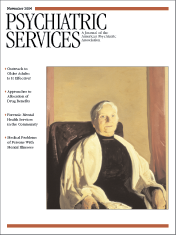Forensic Assertive Community Treatment: Preventing Incarceration of Adults With Severe Mental Illness
Abstract
OBJECTIVE: Persons with severe mental illness are overrepresented in jails and prisons in the United States. A national survey was conducted to identify assertive community treatment programs that have been modified to prevent arrest and incarceration of adults with severe mental illness who have been involved with the criminal justice system. METHODS: Members of the National Association of County Behavioral Health Directors (NACBHD) were surveyed to identify assertive community treatment programs serving persons with criminal justice histories and working closely with criminal justice agencies. Programs were identified that met three study criteria: all enrollees had a history of involvement with the criminal justice system, a criminal justice agency was the primary referral source, and a close partnership existed with a criminal justice agency to perform jail diversion. Senior representatives of each program were subsequently contacted, and a telephone survey was administered to gather information about the design and operation of the programs. RESULTS: A total of 291 of 314 NACBHD members (93 percent) responded to the survey. Sixteen programs that met the study criteria were identified in nine states. The primary referral sources for 13 of these programs (81 percent) were local jails. Eleven programs (69 percent) incorporated probation officers as members of their assertive community treatment teams. Eight programs (50 percent) had a supervised residential component, with five providing residentially based addiction treatment. Eleven of the 16 programs have begun operating since 1999. Only three programs have published outcome data on program effectiveness. CONCLUSIONS: Forensic assertive community treatment is an emerging model for preventing arrest and incarceration of adults with severe mental illness who have substantial histories of involvement with the criminal justice system. Further research is needed to establish the structure, function, and effectiveness of this developing model of service delivery.



